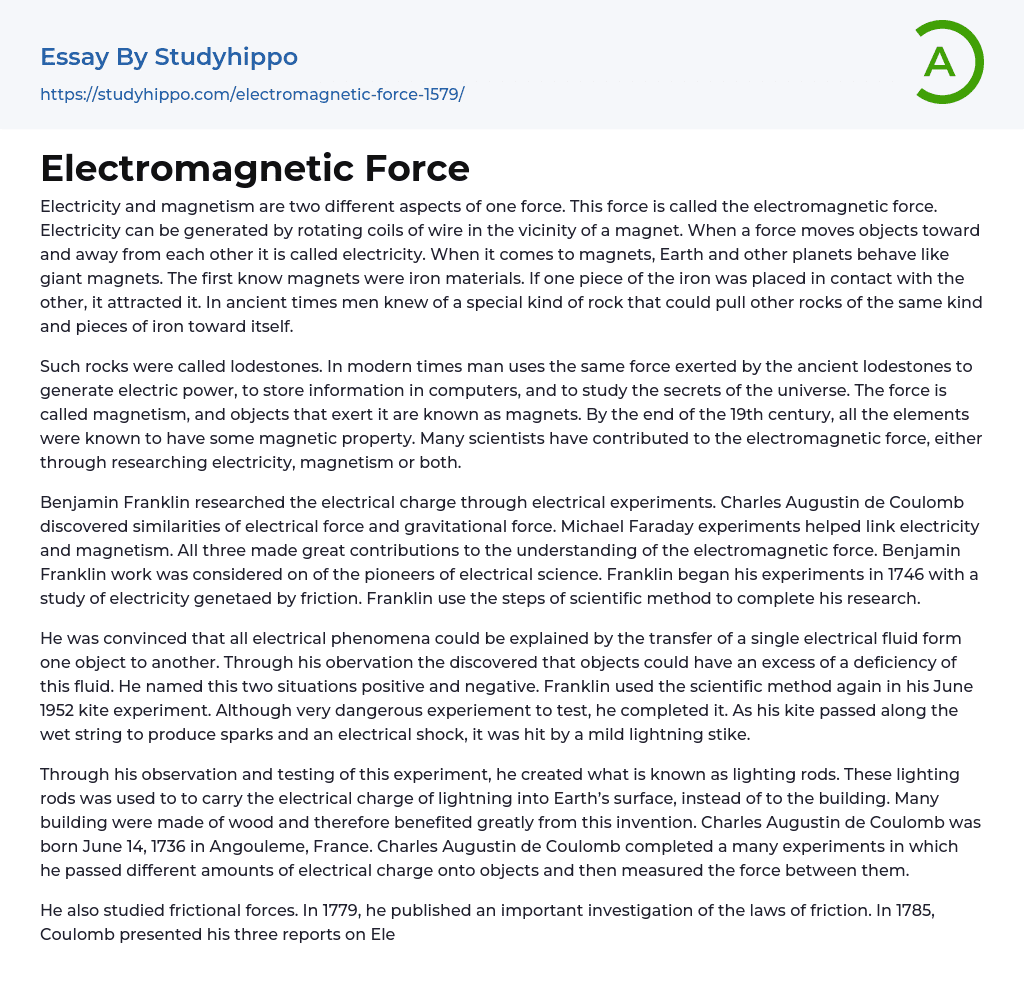Electricity and magnetism are both forms of the electromagnetic force. This force can be produced by rotating coils of wire near a magnet. When objects are moved towards or away from each other by a force, it is referred to as electricity. Earth and other planets also function as magnets. The earliest magnets were constructed with iron. If two iron pieces were brought together, they would attract one another. In ancient times, individuals found a unique kind of rock that had the capability to attract rocks of the same type and even iron fragments.
Lodestones, known as such rocks, were the ancient source of a force now utilized by mankind for electricity generation, computer data storage, and exploration of the universe's mysteries. This force is called magnetism and objects possessing it are magnets. By the end of the 19th century, it was determined that all elements have some magnetic property. Several scientists have c
...ontributed to our understanding of electromagnetic force by exploring electricity, magnetism, or both.
Benjamin Franklin conducted electrical experiments to research the electrical charge. Charles Augustin de Coulomb observed similarities between electrical force and gravitational force. Michael Faraday's experiments helped establish a connection between electricity and magnetism. All three individuals significantly contributed to the understanding of the electromagnetic force. Franklin's work is considered pioneering in the field of electrical science. He initiated his experiments in 1746, focusing on electricity generated through friction. Franklin employed the scientific method as a framework to complete his research.
He believed that electrical phenomena could be explained by the transfer of a single electrical fluid between objects. He observed that objects could have an excess or deficiency of this fluid, whic
he called positive and negative. Franklin later conducted a dangerous experiment in June 1752, using a kite. Despite the danger, he successfully completed the experiment, with the kite producing sparks and an electrical shock as it passed along a wet string. The kite was also struck by a mild lightning strike.
Charles Augustin de Coulomb, born on June 14, 1736 in Angouleme, France, conducted experiments and observations, leading to the creation of lighting rods. These rods were designed to redirect the electrical charge of lightning from buildings and into the Earth's surface. This invention proved highly beneficial for buildings constructed with wood. Coulomb's experiments involved applying varying amounts of electrical charge to objects and measuring the resulting force between them.
He studied frictional forces and published an investigation of the laws of friction in 1779. In 1785, he presented three reports on Electricity and Magnetism, which described the construction and use of an electric balance, the behavior of magnetic and electric fluids, and the measurement of Electricity. He repeatedly observed and tested these experiments using the scientific method. He concluded that the electrical force was similar to the gravitational force discovered by Issac Newton many years earlier.
Using the scientific method, Coulomb observed that if two electrically charged objects are moved farther apart, the force between them decreases, similar to gravity. He summarized this finding in the Coulomb law. Michael Faraday, an esteemed scientist of the nineteeth century, was born on September 2, 1791, in Newington, England. In approximately 1810, he started attending meetings of the recently established City Philosphical Society, where he listened to lectures on various scientific topics. Among these subjects, chemistry and electricity fascinated him
the most.
Faraday collaborated with Sir Humphry Davy, whom he greatly admired, and conducted scientific experiments that connected electricity and magnetism. His research was instrumental in recognizing light as an electromagnetic phenomenon, which eventually led to the utilization of electromagnetic waves in communication. In 1820, Faraday achieved a significant breakthrough - he successfully synthesized carbon and chlorine compounds by substituting chlorine for hydrogen in ethylene.




